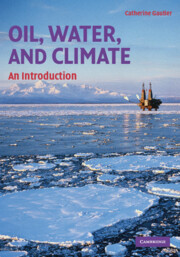Book contents
- Frontmatter
- Contents
- Foreword
- Introduction
- 1 Overview
- 2 Carbon Dioxide Emissions, Global Warming, and Water Resources
- 3 Population, Environmental Impacts, and Climate Change
- 4 Carbon Cycle and the Human Impact
- 5 Peak Oil, Energy, Water, and Climate
- 6 Oil Consumption and CO2 Emissions from Transportation
- 7 Oil, Economy, Power, and Conflicts
- 8 Energy Alternatives and Their Connection to Water and Climate
- 9 The Water Cycle and Global Warming
- 10 Fresh Water Availability, Sanitation Deficit, and Water Usage: Connection to Energy and Global Warming
- 11 Rivers, Lakes, Aquifers, and Dams: Relation to Energy and Climate
- 12 Water Contamination, Energy, and Climate
- 13 Geopolitics of Water and the International Situation
- 14 Water Alternatives
- 15 Global Climate Change: Observations, Modeling, and Predictions
- 16 Energy and Water Challenges and Solutions in a Changing Climate Framework: Commonality, Differences, and Connections
- References
- Index
4 - Carbon Cycle and the Human Impact
Published online by Cambridge University Press: 05 September 2012
- Frontmatter
- Contents
- Foreword
- Introduction
- 1 Overview
- 2 Carbon Dioxide Emissions, Global Warming, and Water Resources
- 3 Population, Environmental Impacts, and Climate Change
- 4 Carbon Cycle and the Human Impact
- 5 Peak Oil, Energy, Water, and Climate
- 6 Oil Consumption and CO2 Emissions from Transportation
- 7 Oil, Economy, Power, and Conflicts
- 8 Energy Alternatives and Their Connection to Water and Climate
- 9 The Water Cycle and Global Warming
- 10 Fresh Water Availability, Sanitation Deficit, and Water Usage: Connection to Energy and Global Warming
- 11 Rivers, Lakes, Aquifers, and Dams: Relation to Energy and Climate
- 12 Water Contamination, Energy, and Climate
- 13 Geopolitics of Water and the International Situation
- 14 Water Alternatives
- 15 Global Climate Change: Observations, Modeling, and Predictions
- 16 Energy and Water Challenges and Solutions in a Changing Climate Framework: Commonality, Differences, and Connections
- References
- Index
Summary
Carbon is distributed in Earth's system components: atmosphere, ocean, land, soils, and vegetation. It cycles in the system between various reservoirs where it is stored for different lengths of time (known as the “residence time” of carbon). Carbon exchanges affect atmospheric CO2 concentration: both land and ocean act as carbon sinks. Natural and anthropogenic processes affect the carbon cycle, which is strongly connected to the climate.
Introduction
Since the birth of the solar system nearly five billion years ago, carbon has been cycling in a closed loop on planet Earth. Within this loop, carbon is exchanged among different pools (e.g., atmosphere, oceans, soils, organic matter, sediments, rocks) where it can reside for various periods of time – in some cases, up to millions of years (e.g., hydrocarbons such as oil). Billions of years ago, this natural carbon cycle had a large variability as Earth oscillated between greenhouse eras (when no ice sheets were present on Earth) and icehouse eras (when ice sheets were present). For millions of years, the carbon cycle essentially has depended on the balance between volcanic CO2 input (source) and CO2 removal by chemical weathering (sink), the intensity of the latter serving as a thermostat ensuring that Earth's climate remains within narrow limits and the planet remains habitable. This balance kept the size of the “natural” atmospheric carbon reservoir relatively constant at about 600 gigatons.
- Type
- Chapter
- Information
- Oil, Water, and ClimateAn Introduction, pp. 59 - 80Publisher: Cambridge University PressPrint publication year: 2008



